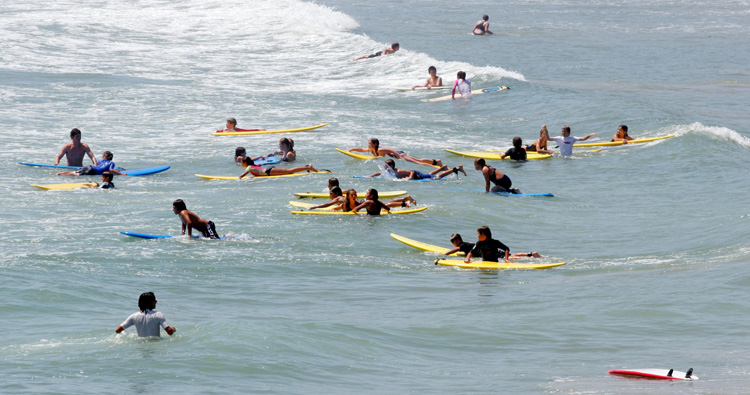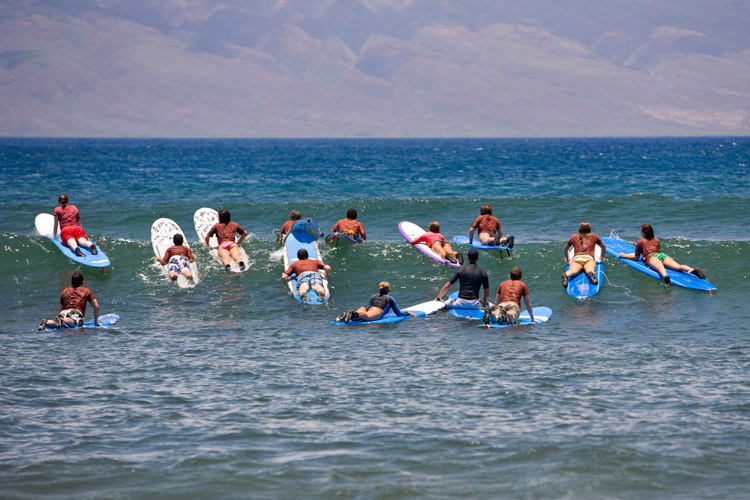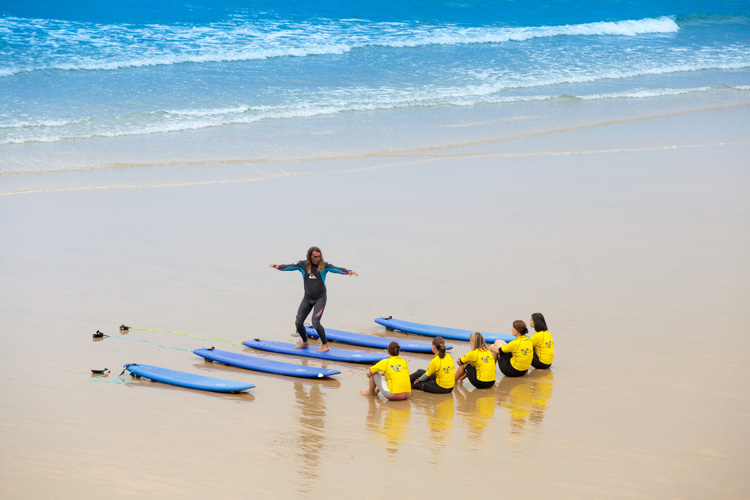Do you want to become a fully licensed surf instructor? Do you want to share your surfing knowledge with others while earning a salary for your work? Discover the basic skills required to be a surfing instructor.
First, you need to know that you can't initiate a surf coaching career just because you have decades of experience out in the water.
Like surf schools, instructors must be certified to teach surf.
Surf lessons are serious business. You can't predict Nature's behavior and must ensure everyone stays safe and doesn't put others at risk.
The International Surfing Association (ISA) is the governing body for the sport of surfing.
Therefore, it is the only organization you should consider to receive formal and officially recognized training as a surf instructor.
The ISA Surf Coaching & Instructing Educational Program is the internationally recognized standard accreditation used in the surf school world.
There's much to learn:
- Coastal regulations;
- Safety procedures;
- Ocean risks and hazards;
- Emergency actions;
- Lesson planning;
- Equipment and gear knowledge;
- Communication skills;
- Coaching methods;
- Student evaluation;
- Environmental practices;

The Golden Rules
A surf instructor should never teach more than eight beginner surfers per class. Novice wave riders should ride their first wave on foam, soft-top surfboards.
- Arrive early enough to check conditions and liaise with the lifeguard;
- The role/list of names, disclaimers, and contact phone numbers must be recorded at the start of the lesson;
- Allocate the appropriate surfboard to each participant and reinforce the correct way to carry the board and leg rope;
- Each participant will be given one rash shirt to wear during the lesson. The rash shirts should all be the same color and assist in signifying the group;
- Ensure there is a first aid kit, a whistle, a mobile, and a rescue device on the beach in close proximity;
- Each lesson should include a surf safety talk that covers the day's conditions and possible hazards;
- The aims and objectives of the lesson need to be clearly stated before starting;
- Ensure enough distance to eliminate the chance of the group mixing in the water with other groups;
- Structure the group so that there is a constant vision of every participant 100 percent of the time;
- In cases of side drift, structure the lesson so that participants drift toward the coach, not away;
- Instruct participants to follow the philosophy of one person per wave;
- Instruct participants to allow a safe distance between each other to avoid collisions;
- Ensure the recall/danger signal is reinforced and correctly responded to;
- Each skill must be demonstrated on the beach, in the water, by the coach, or by an experienced assistant. Participants need to be positioned to enable them to view the demonstration;
- The teaching methodology must be: demonstrate, participate, feedback, demonstrate, participate, feedback, and so on;
- Regularly reinforce the need to follow the said recall signal;
- Participants must be first competent at negotiating the surf, catching waves in the prone position with correct hand placement, and being able to traverse before being shown the prone-to-feet technique;
- Regular beach practice reinforces correct techniques and gives a recovery period for participants;
- Never leave a group in the water unattended for any reason. Recall the group to shore, then do what is pressing;
- Avoid standing next to other coaches, as this will result in the two groups coming together and increasing the chance of accidents;
- At the completion of the lesson, regroup all groups together, check numbers, discuss positive outcomes, and then dismiss them as one large group;
- Any accidents, even minor ones, must be reported immediately to the head coach;

Teaching Basic Techniques
According to the ISA, the surfing technique can be divided into primary and secondary skills. The basic techniques (primary skills) are as follows:
- Paddling: through the break and onto waves;
- Take-Off: Board breaking away and standing action;
- Trimming: sliding, traversing (cut across the wave's face), tube-riding, and nose riding;
- Turning: forehand, backhand, and cutback;
The instructor should attempt to develop these skills through progressive classes and by choosing various locations that require/allow additional work in specific areas.
The secondary skills are an extension of basic techniques leading to more dynamic surfing maneuvers and more skillful use of the forces within the wave.
These maneuvers include tube riding, re-entries of all types, side slipping, stalling moves, air moves, and a variety of turns customized to fit the fluid dynamics of the given wave.
A refined feel for the wave is exhibited by the surfer's body leverage skills, timing, judgment, and positioning, all brought into focus by his/her selection of maneuvers in the flow of the wave.
The instructor should stress the "feel" of the board and wave and continually bring these new skills to the attention of the student.
Wave knowledge is necessary for increased performance, so a discussion of wave characteristics should be an essential part of every class.
Skill Levels
Surf instructors should adapt their lessons to the class in front of them and avoid groups with a large ability range.
The ISA listed seven different skill levels:
- Class 1: Never seen board before;
- Class 2: Able to paddle a board in flat water;
- Class 3: Paddle onto broken waves;
- Class 4: Ability to ride white water (broken wave) standing;
- Class 5: Catch unbroken waves and turn in either direction;
- Class 6: Ability to perform carving cutbacks;
- Class 7: Ability to produce carving turns and cope with re-entries;
Remember that beginner surfers tend to overestimate their ability.
A surf instructor must be aware, ask questions, and choose the location of the class, the ability level, and the lesson content as guiding parameters.
